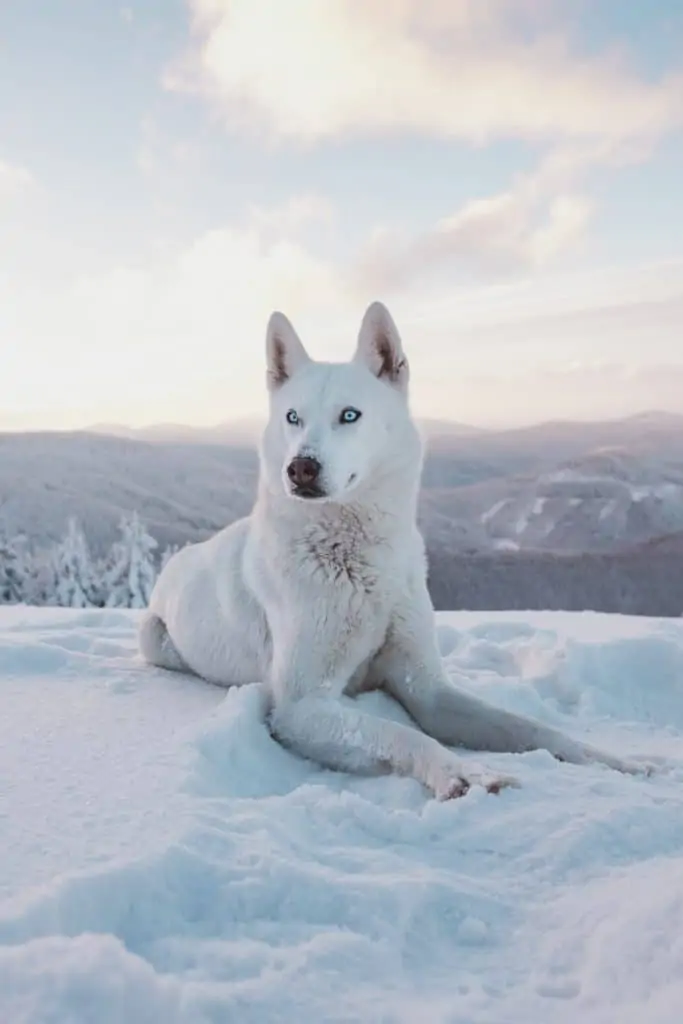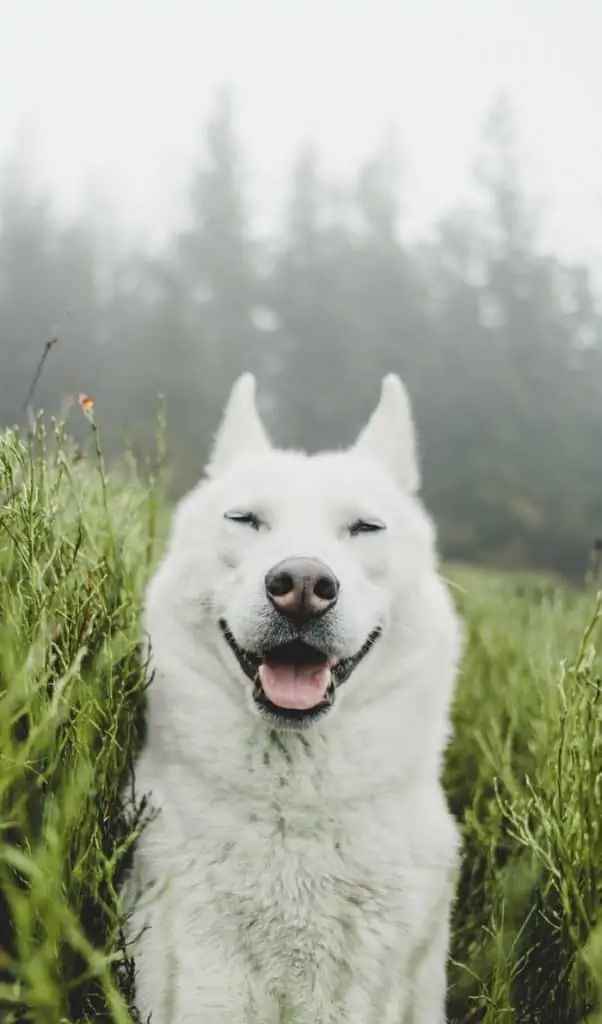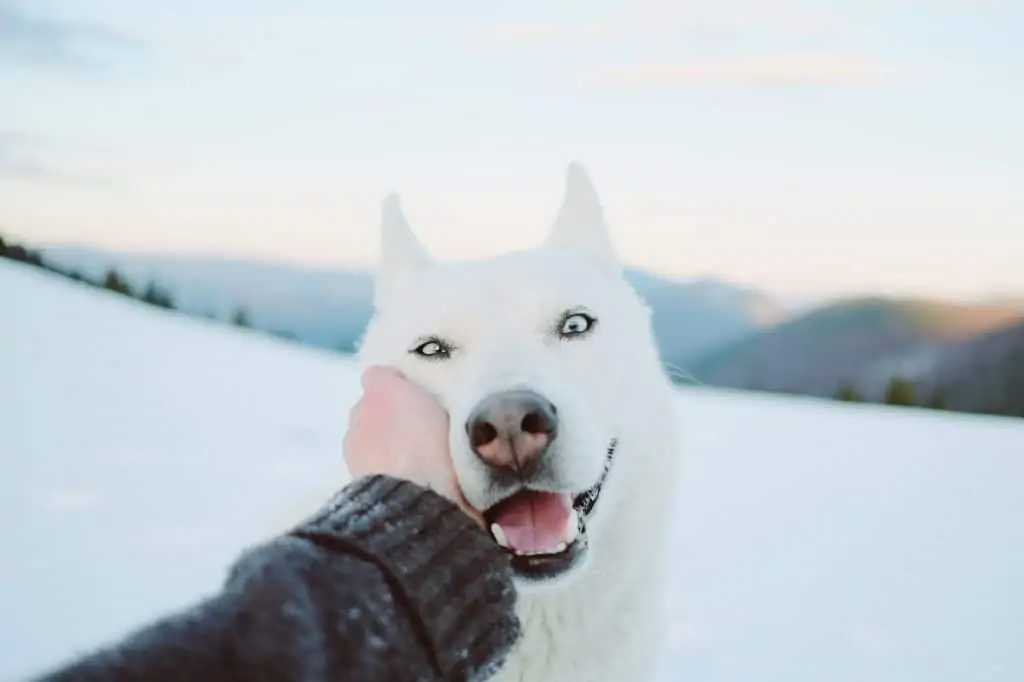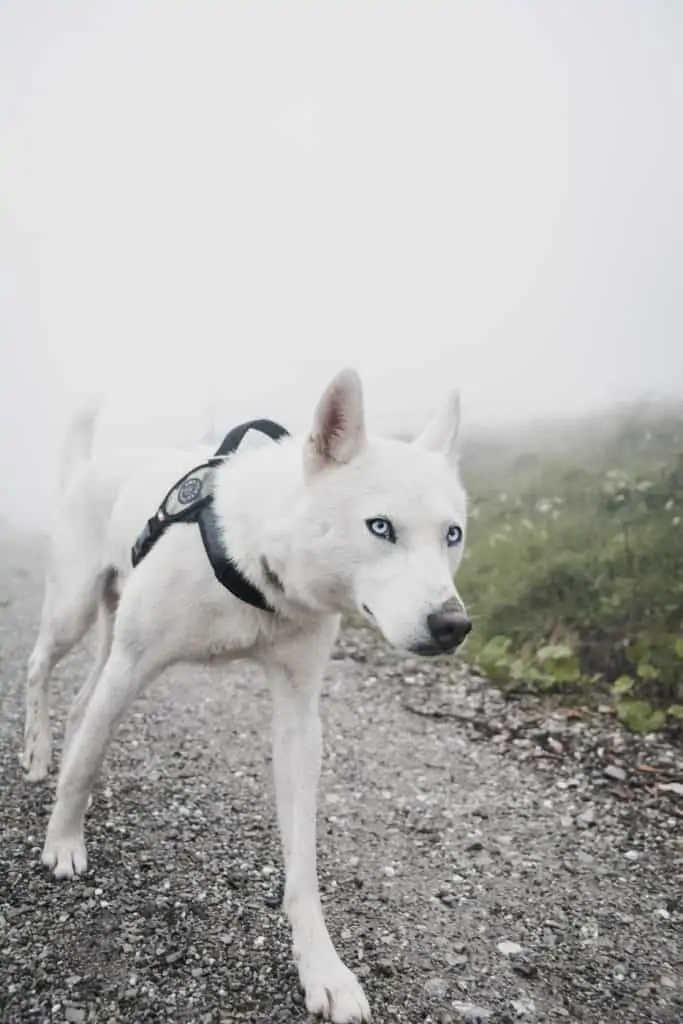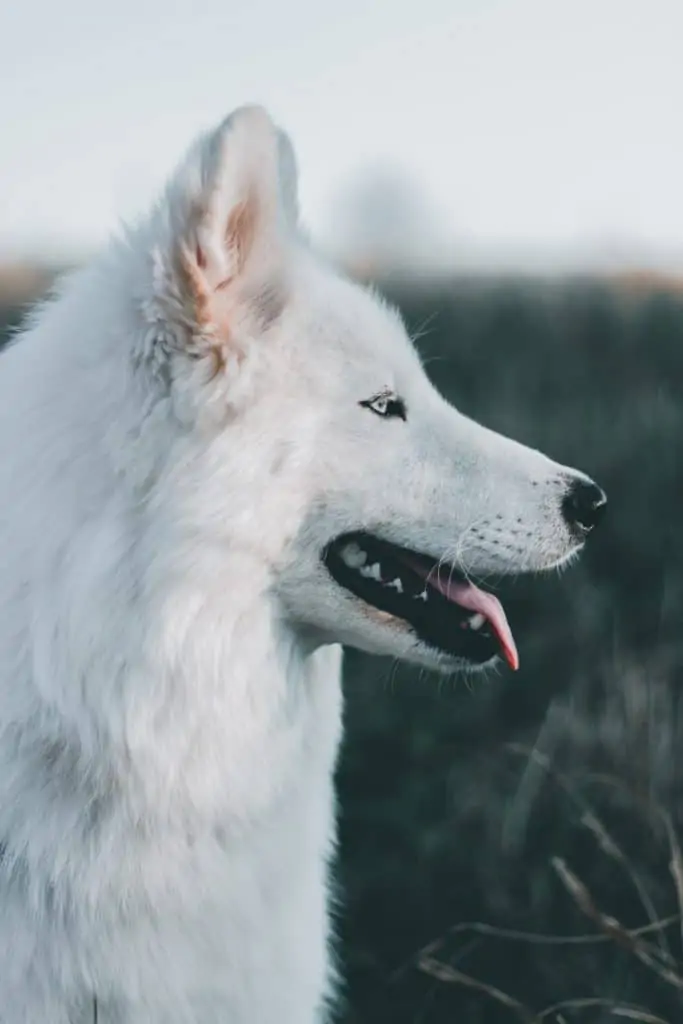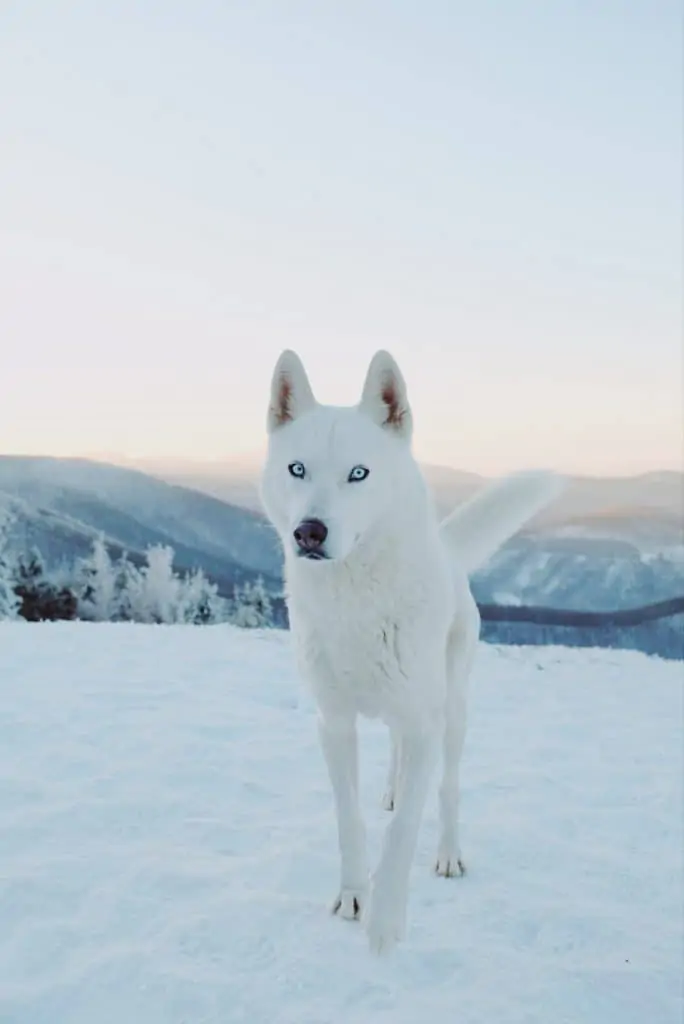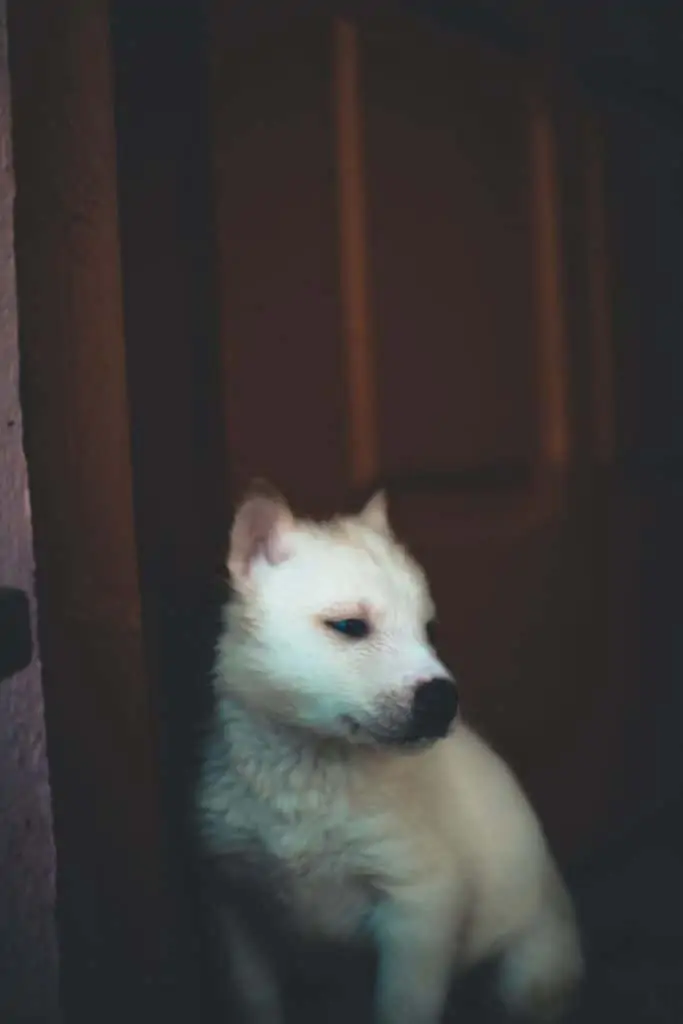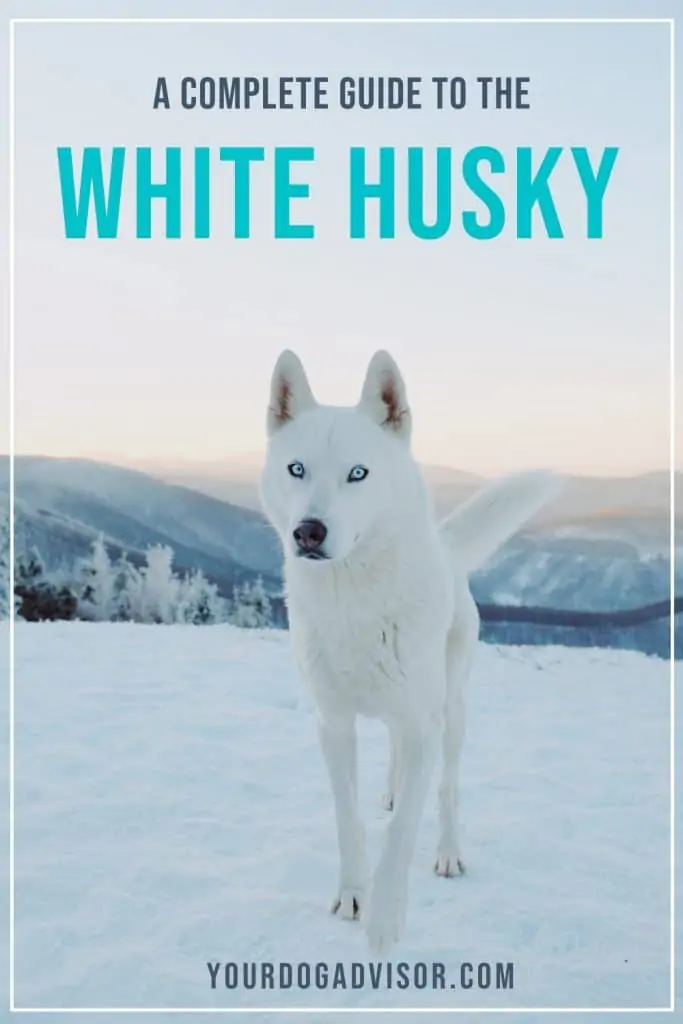Are you considering welcoming a White Husky into your home? Learn about this enchanting breed’s history, characteristics, and care requirements. Uncover the reasons behind their allure and determine if this energetic, blue-eyed beauty is the perfect addition to your family.
Siberian Huskies are already one of the United States’ most popular dog breeds. Ranking at number 14 out of 197 on the American Kennel Club’s list of most popular dog breeds, it’s no surprise this energetic purebred is on your mind.
And when it comes to the white Siberian Husky, there is perhaps no dog as beautiful. That said, there’s a reason you don’t see too many white Huskies roaming about your neighborhood.
This Husky color is actually pretty rare, prompting some breeders to even charge a bit more for a white Husky with blue eyes. Is this fair?
That’s what we’re here to find out. Join us today as we go over everything you should know about the white Husky.
Contents
The White Husky – A Breed Overview
The White Husky is a purebred color variation of the Siberian Husky.
Height: 20 to 23.5 Inches
Weight: 35 to 60 Pounds
Temperament: Devoted, Playful, Mischievous, Energetic
Ideal For: Active families with children and other pets, or outgoing singles and couples.
Lifespan: 12 to 14 Years
Health Issues: Deafness, Cataracts, Corneal Dystrophy, Progressive Retinal Atrophy, Uveodermatologic Syndrome, Hip Dysplasia, Zinc Deficiency, Follicular Dysplasia, And Hypothyroidism
Breed Clubs:
- The American Kennel Club
- The Siberian Husky Club of America, Inc
- The United Kennel Club
Working Breeds And Huskies – What You Should Know About The White Husky Temperament
Like all Huskies, the White Husky is energetic, playful and very outgoing.
The Siberian Husky is a bred working dog hailing from Siberia. Bred and perfected by the ancient Chukchi people, the Husky was developed as a versatile sled dog. He played a number of roles in the Chukchi people’s survival, serving also as a protection dog, hunting dog, and trusted companion.
Today, Huskies are still one of the most popular dogs used for competitive sled racing. As such, Huskies are bred for endurance. They are extremely energetic, people-oriented, social and athletic.
All of these aspects and the fact that the white Husky is a bred working dog should be taken into consideration when considering a white Husky’s temperament in and outside of the home.
The White Husky With Children
One of the greatest things about the white Husky is that he is incredibly friendly and people-oriented. His playful, mischievous personality means he makes an excellent companion for children. He is gentle and fun-loving, and will enjoy having youngsters to run around with.
However, it’s important to note that all dogs are capable of behavioral issues that can lead to aggressive tendencies. This is especially true if dogs are not trained or properly socialized at an early age.
We also suggest that, if you plan on raising a white Husky with children, you monitor your children around the dog and ensure kiddos understand how to respectfully interact with their four-legged companion.
The White Husky With Strangers
A properly socialized white Husky will do well with strangers. While this doesn’t make him the ideal guard dog, it is nice to know that you’ll be able to bring your Husky almost anywhere without too many issues.
Huskies are friendly and social, and this was an ideal trait during their working days in Siberia. They enjoy people and are very family oriented. This means that your white Husky is also not meant to be living alone outdoors.
Huskies who are left alone without interaction with people or their families can become very distressed, leading to serious behavioral and emotional issues in the breed.
The White Husky With Other Dogs
Do you have other dogs in the home? Then a white Husky is a great addition to consider. White Huskies are friendly, social dogs who thoroughly enjoy having other doggy playmates. In fact, many owners with Huskies will tell you that having two Huskies is actually easier than having one.
This is due to the Husky’s high energy level and playful nature. Oftentimes another Husky playmate is better at keeping your dog entertained in the long haul than you will be.
Training and Socializing A White Husky
Training and socialization are key to your White Husky living a happy and well-rounded life.
All dogs require a good amount of training and socialization, and the white Husky is no exception. Even though this breed is known for being friendly, outgoing and confident, he can still be prone to behavioral issues if not properly trained and socialized.
Some common behavioral issues in the breed that are a direct result of inadequate training and socialization include:
- Chewing
- Barking
- Jumping
- Pulling on Leash
- Howling
- Digging
- Fear-Based Aggression
- Resource Guarding
- And Marking
Of course, many of these issues in a white Husky also come with not being adequately exercised, but we’ll discuss that further down. For now, let’s dive a little deeper into training and socialization.
Socialization
It is never too early to begin working on socialization with your white Husky puppy. While many vets recommend waiting until your puppy is fully vaccinated before taking him out and about, there are still many things you can do at home to ensure he is meeting all of his socialization milestones.
Bring your white Husky with you on as many outings and errands as possible and, once he is fully vaccinated, introduce him to as many new people, places, sounds, sights, experiences and other dogs as you can.
Try and ensure that these new experiences are positive for your white Husky, and avoid forcing him into situations that are clearly frightening for him.
Training A White Husky
White Husky dogs are larger, athletic breeds. This means they are strong and powerful, so it is best to begin training early on while your white Husky is still a puppy. Of course, it’s never too late to begin training a Husky at any age.
We should also note that white Huskies are intelligent, albeit mischievous. They can be hard headed at times and become bored easily, which can make training frustrating for the novice dog owner.
However, if you do your research and learn a bit about how the white Husky learns, you should be able to create a tight bond with your dog that makes training much easier.
White Huskies learn best when positive reinforcement is utilized. This should include lots of treats and praise, and training sessions that feel like games to your white Husky.
Avoid punishing your dog if he becomes bored during training, and be patient with him. White Husky dogs are sensitive and can be prone to shutting down if they feel you are disappointed in them.
The Typical Exercise Needs Of A White Husky
White Huskies can require two hours or more of exercise a day as well as plenty of free playtime.
It’s common knowledge that Huskies as a breed are high energy dogs. This incredible energy level means that these dogs can be overwhelming for the unprepared owner. Sadly, this leads to many Huskies being turned over to shelters.
That said, if you are prepared for your Husky’s energy, you’ll be able to work with him to ensure he has all of his needs met.
Physical Exercise
The white Husky will need routine physical exercise each and every day. Exercise not only helps your Husky stay healthy by ensuring his heart, bones, joints and muscles are strong, it also keeps him mentally sound and can reduce stress, anxiety and behavioral issues that can weaken his immune system as he ages.
The proper exercise for a Husky will include about two hours of scheduled walks, jogs, swimming, or hiking. Along with these exercise routines, your Husky will also need plenty of free playtime in a securely fenced backyard.
Huskies are generally not the best apartment dogs. While they can enjoy fun playtime at a dog park from time to time, they will need lots of time outdoors and the option to run around or get outside whenever they feel a burst of energy. Having a securely fenced yard will also help you manage your Husky when you are busy.
When exercising your white Husky, keep in mind that this is a breed who may have a natural urge to pull on leash. He is a bred sled dog, afterall. Traditional harnesses that clip to your Husky’s back can increase his natural urge to pull.
For this reason, it’s best to use front clip harnesses and other equipment that not only reduce pulling, but also make walking more comfortable for both you and your dog.
2 Hounds Freedom Harness
No products found.
The Freedom Harness above is one we commonly use for the Husky dogs in our care. This harness allows for better control and reduces the white Husky’s natural instinct to pull against pressure on his back by clipping to his chest. It also fits him more comfortably without putting too much pressure on his chest or throat.
You can order this harness in different sizes, though remember it should fit snugly on your white Husky, so be sure to do your measurements.
Mental Stimulation
Huskies are not only energetic, they are also intelligent. As working breeds, these dogs will do well with consistent mental stimulation throughout their lives that is designed to keep them engaged.
You can consider setting up obstacle courses in your yard to help challenge and exercise your white Husky at the same time. Your white Husky will also enjoy playing games like hide and seek, fetch, and tag.
Interactive toys like puzzle toys, slow feeders and KONGS can also help keep your white Husky engaged and happy, especially when you are busy during the day or when you’re gone.
We should also mention here that even with proper training and exercises, Huskies can become destructive. These dogs are curious and mischievous by nature, so they are great candidates for crate training.
Crate training your white Husky can be highly beneficial and reduce anxiety, stress, and dangerous behaviors in the dog. Many experts recommend implementing these techniques for dogs who are prone to getting themselves into mischief when their owners are away.
MidWest Homes Large Dog Crate
No products found.
The above dog crate by MidWest Homes is ideal for large breed dogs like the white Husky. It also includes a divider, which can help your Husky adjust if he is a small puppy during crate training.
We also like that this crate folds flat for storage and is easy to travel with. To make it as cozy as possible for your white Husky, we recommend investing in crate pads and some bedding. You might also consider investing in a crate cover.
How To Groom A White Husky
As a breed, Siberian Huskies have dense, double coats that require routine brushing.
White Husky dogs are known for their stunning, bright white coats. And while these coats can certainly turn some heads, they can also seem daunting when it comes to grooming.
However, you may be surprised to learn that the white Husky is actually a relatively easy dog to groom. This dog’s coat is weather resistant and self cleaning, meaning bathing will only need to occur once every six weeks or so, unless your Husky gets especially dirty in the meantime.
Of course, because this particular Husky is white, he will be more prone to grass stains, debris buildup, dirt, and tear stains on his fur. We recommend investing in grooming wipes that you can use on your white Husky between bathtime to help keep his coat looking its best.
White Huskies will also need to be brushed routinely. Their double coats are dense and they shed heavily, especially twice a year during shedding season. Outside of shedding season, the white Husky should be brushed once or twice a week with a quality deshedding brush and undertake comb designed to get into his downy undercoat and remove loose fur and debris.
During shedding season, which occurs in spring and fall, you may need to brush your white Husky once a day or at least a few times a week.
The Furminator Undercoat Deshedding Tool
No products found.
One of our favorite brushes for Huskies, or any double coated breed for that matter, is the Furminator Undercoat Tool. This is a self-cleaning tool designed to get into your dog’s fur and take out all that built up hair and debris from his wooly undercoat.
Using this rake helps not only remove loose hair and keep your Husky looking his best, but it also reduces the chances of your white Husky developing skin and coat issues as well as doggy odor.
Along with routine brushing, your white Husky should have his ears checked and cleaned regularly.
White Huskies should also have their nails trimmed or ground down every few weeks to keep them from cracking and splitting, and they will need their teeth brushed at least once a day with a dog safe toothbrush and toothpaste to help keep dental issues at bay.
White Husky Lifespan And Health Issues
White Huskies carry the piebald gene, which makes them more susceptible to deafness.
As a breed, Siberian Huskies are relatively healthy and long-lived. The white Husky, being a color variation of Husky, is no different. However, there are some genes associated with white dogs that can lead to some unique health issues you should be aware of.
White Husky Lifespan: 12 to 14 Years
White Husky Health Issues:
- Deafness
- Cataracts
- Corneal Dystrophy
- Progressive Retinal Atrophy
- Uveodermatologic Syndrome
- Hip Dysplasia
- Zinc Deficiency
- Follicular Dysplasia
- And Hypothyroidism
What You Should Know About Deafness In White Dogs
Deafness and white pigmentation in dogs has been linked, so it’s important to consider this when considering a white husky. This is due to the piebald gene, which is carried in white dogs and cats. The piebald gene occurs when there is a lack of melanocytes, which are cells that help determine coat and eye color.
Dogs who are white and (often) have blue eyes, are missing melanocyte cells. Melanocyte cells not only help determine coat and eye color, but they also play a role in your dog’s hearing. The same stem cell source that forms melanocytes helps design the function of your dog’s inner ear, and if your dog is missing these cells, he is more likely to be deaf.
However, not all dogs who are white are going to be deaf. Furthermore, it’s not only the white dogs that suffer from a higher rate of deafness. Gray dogs, merle colored dogs, and dogs like dalmatians are also affected by this trait due to carrying the same piebald gene.
Tips On Keeping Your White Husky Health:
- Go Through A Reputable Source
You can avoid deafness in your dog by being careful which source you get him from. A responsible breeder will have health screened their puppies for chances of deafness and other issues in the breed before placing them for sale.
However, if you do wind up with a deaf White Husky, don’t worry. There are plenty of resources available to help you and your Husky live your happiest lives together regardless.
- Consider Having Your White Husky Health Screened
If you rescue a white Husky or your breeder did not provide health screening certificates, (more on that further down), you can always consider having your white Husky health screened yourself.
According to the National Breed Club, the Siberian Husky should undergo an Ophthalmologist Evaluation and a Hip Evaluation.
For more information on health screening your Husky, you can read the official breed club health statement for a Siberian Husky here.
- Keep Your Husky On A Healthy Diet
A quality diet will also play a role in your white Husky’s overall health. The best dog food for Husky dogs is going to be a dog food that is specified for your Husky’s age, weight and activity level.
Choose high quality dog foods that are free of additives, fillers, byproducts, corn, gluton, wheat or soy. Instead, pick a dog food where real meat protein is the first ingredient, like the dog food listed below by Blue Buffalo.
Blue Buffalo Protection Formula Dog Food
No products found.
The above dog food by Blue Buffalo is made with quality ingredients that are ideal for larger, high-energy breeds like the white Husky. This dog food is made with holistic ingredients and includes real meat protein, carbs, fatty acids, vitamins, minerals, and is even a good source of water.
You can order this dog food in different recipes as well, which is ideal if your unique white Husky has allergies or food sensitivities. For dogs with food issues, we recommend a recipe that is free of poultry.
Keep Up With Routine Vet Visits
Last, be sure to keep up with routine veterinary visits with your white Husky. Just like people, dogs should be seen at least once a year for checkups.
Keeping up with routine vet visits not only ensures your Husky is happy and healthy, but it can also catch issues early on and allow for your vet to intervene before things become too serious or expensive.
If you are concerned about medical costs when it comes to your white Husky, you always have the option of purchasing pet health insurance.
The Ideal Home Type For A White Husky
The White Husky will do best with active dog owners who understand and can accommodate their high levels of energy.
Are you considering investing in a white Husky? Remember, while these dogs are friendly, social and affectionate, they can also be quite overwhelming for the unprepared or novice dog owner.
Before you decide if a white Husky is right for you, it’s important to consider your lifestyle, home type, and daily routine.
When it comes to a white Husky, the ideal home is one with a large and securely fenced backyard. Husky dogs can be diggers, so we also recommend having a fence that is reinforced below ground to reduce potential escapes.
The ideal owner for a white Husky will be an active family with children or other dogs, or singles or couples looking for a dog that makes a great exercise companion.
Huskies love adventure, and they make wonderful road trip buddies so long as their exercise needs are met. However, if you are looking for a more go-with-the-flow type of dog who will be content lounging by the fireplace all day, don’t get a Husky.
These dogs require consistent exercise and maintenance, and a Husky whose needs are neglected is going to be a very difficult Husky indeed.
For this reason, Huskies are best suited for experienced dog owners or dog owners who are willing and committed to learning more about the Husky temperament, energy level, and overall care requirements.
Where To Find A White Husky Puppy or Rescue Dog
White is the most rare Husky color, so finding a white Husky could take time.
If you’ve decided that the white Husky is your dream dog, we want to help you get your hands on one.
Unfortunately, white Huskies are the most rare color of Husky available, which means they can be difficult to come by. Your best bet is to go through a reputable breeder early and put a request in for a white Husky born to their litter.
You may need to pay a bit more up front, but this is not always the case. Remember, white Husky dogs do come with a few more health issues, and most reputable breeders will not charge extra for a Husky with a white coat color.
That said, female white Huskies generally cost more than males when going through a breeder, and white Huskies with working-quality or show quality parent breeds will be more costly as well.
On average, buying a white Husky through a breeder that is bred specifically for companionship will cost you between $500 and $1,200. A white Husky bred for working purposes or that is deemed show quality will cost more, ranging in price from $1,400 to $6,000.
But what if you want to rescue? Is it possible to find a white Husky at a shelter?
Actually, it is quite possible and it may only require a bit of research and patience on your part. Remember, Husky dogs are sadly turned over to shelters at a slightly higher rate than some other breeds, so there is a good chance the dog of your dreams is waiting for you at a rescue.
On average, it costs between $250 to $500 to rescue a white Husky from a shelter, but there are many more benefits of rescuing that go far beyond cost. For instance, adult Huskies available for adoption may already be spayed or neutered and have undergone some basic training.
Many Huskies who are placed for adoption through a rescue or shelter will have also undergone some behavioral testing, been vaccinated, and received an initial vet exam.
In order to raise your odds of finding a white Husky through a rescue, you might consider going through shelters that specialize in the breed. Call around and ask questions, and request to be placed on a list to be notified if a white Husky becomes available.
And there you have it – everything you need to know about the white Husky. So, do you still think that this is the dog for you?
Let us know what you think about the white Husky in the comment section below.
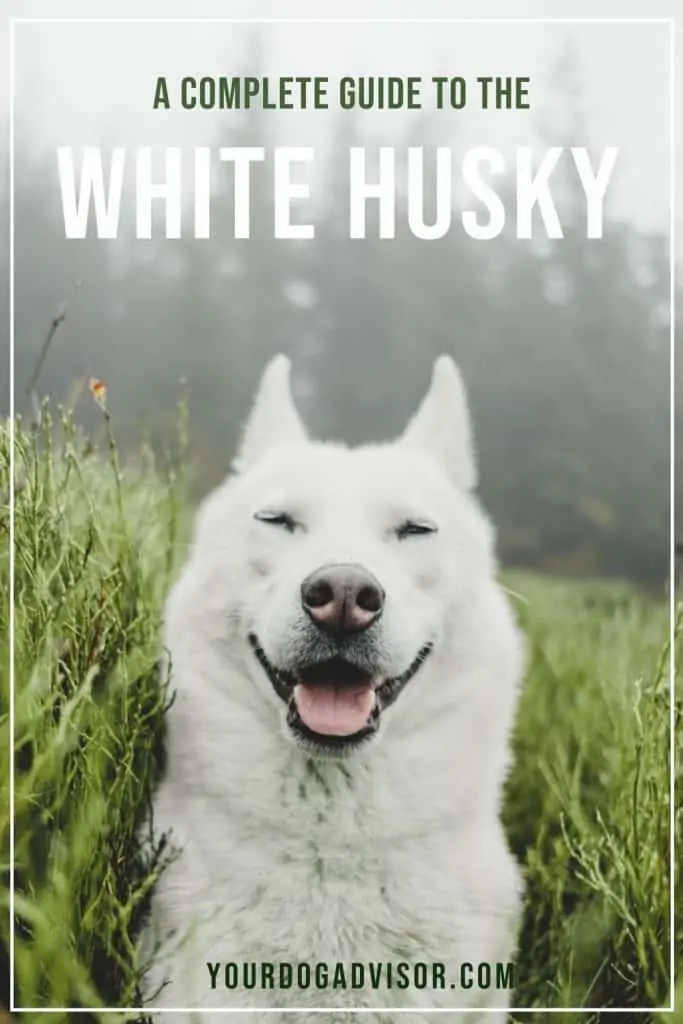

Jen Jones is a professional dog trainer and behavior specialist with more than 25 years of experience. As the founder of ‘Your Dog Advisor’ and the ‘Canine Connection’ rehabilitation center, she applies a holistic, empathetic approach, aiming to address root causes rather than merely treating symptoms.
Well known for her intuitive and compassionate approach, Jen adopts scientifically-proven, reward-based methods, encouraging positive reinforcement over punishment. Jen specializes in obedience training, behavior modification, and puppy socialization. Her innovative methods, particularly in addressing anxiety and aggression issues, have been widely recognized. Jen has worked with many of the world’s leading dog behaviorists and in her free time volunteers with local animal shelters and rescue groups.
